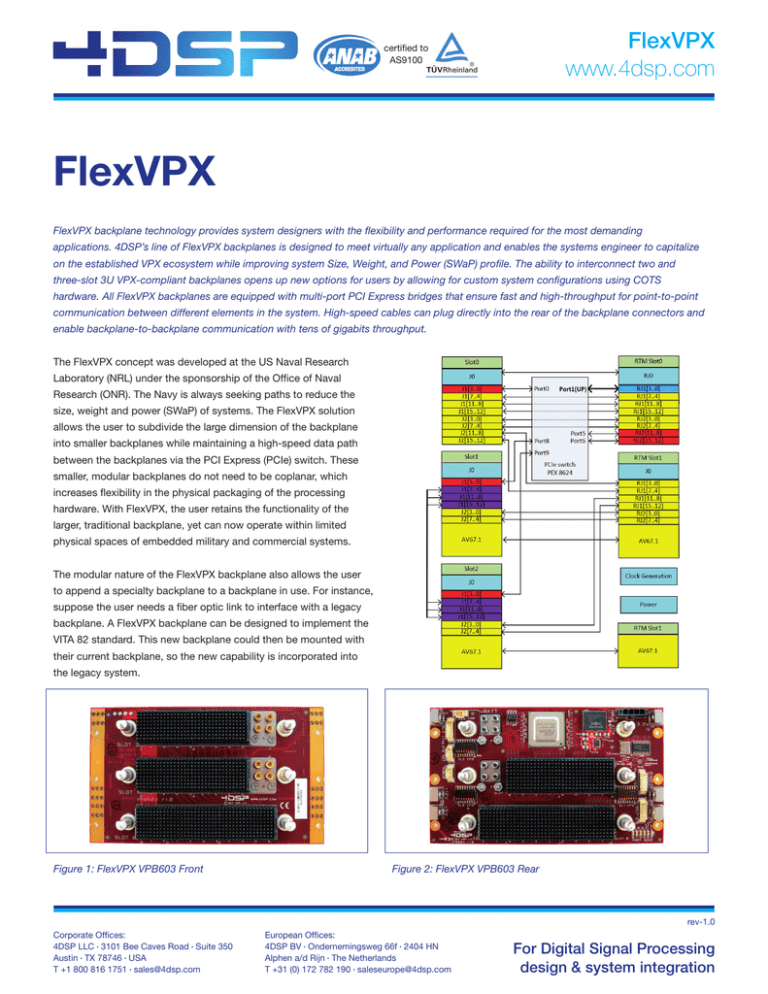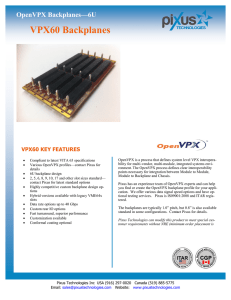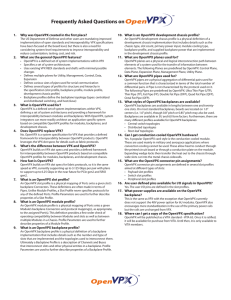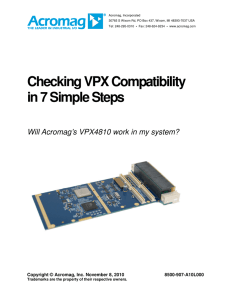paper - 4DSP LLC
advertisement

FlexVPX www.4dsp.com certified to AS9100 FlexVPX FlexVPX backplane technology provides system designers with the flexibility and performance required for the most demanding applications. 4DSP’s line of FlexVPX backplanes is designed to meet virtually any application and enables the systems engineer to capitalize on the established VPX ecosystem while improving system Size, Weight, and Power (SWaP) profile. The ability to interconnect two and three-slot 3U VPX-compliant backplanes opens up new options for users by allowing for custom system configurations using COTS hardware. All FlexVPX backplanes are equipped with multi-port PCI Express bridges that ensure fast and high-throughput for point-to-point communication between different elements in the system. High-speed cables can plug directly into the rear of the backplane connectors and enable backplane-to-backplane communication with tens of gigabits throughput. The FlexVPX concept was developed at the US Naval Research Laboratory (NRL) under the sponsorship of the Office of Naval Research (ONR). The Navy is always seeking paths to reduce the size, weight and power (SWaP) of systems. The FlexVPX solution allows the user to subdivide the large dimension of the backplane into smaller backplanes while maintaining a high-speed data path between the backplanes via the PCI Express (PCIe) switch. These smaller, modular backplanes do not need to be coplanar, which increases flexibility in the physical packaging of the processing hardware. With FlexVPX, the user retains the functionality of the larger, traditional backplane, yet can now operate within limited physical spaces of embedded military and commercial systems. The modular nature of the FlexVPX backplane also allows the user to append a specialty backplane to a backplane in use. For instance, suppose the user needs a fiber optic link to interface with a legacy backplane. A FlexVPX backplane can be designed to implement the VITA 82 standard. This new backplane could then be mounted with their current backplane, so the new capability is incorporated into the legacy system. Figure 1: FlexVPX VPB603 Front Figure 2: FlexVPX VPB603 Rear rev-1.0 Corporate Offices: 4DSP LLC • 3101 Bee Caves Road • Suite 350 Austin • TX 78746 • USA T +1 800 816 1751 • sales@4dsp.com European Offices: 4DSP BV • Ondernemingsweg 66f • 2404 HN Alphen a/d Rijn • The Netherlands T +31 (0) 172 782 190 • saleseurope@4dsp.com For Digital Signal Processing design & system integration FlexVPX www.4dsp.com Multi-Slot Systems With the option to build multi-slot solutions using 4DSP’s six-slot desktop VPX360 and mobile ruggedized VPX362 chassis, users have the opportunity to design a range of systems that feature a small footprint, a high level of ruggedization, and unmatched performance. The FlexVPX backplanes provide the best-in-class computing options for SONAR/RADAR, satellite communications, and Software Defined Radio systems when used with 4DSP’s family of 3U VPX FPGA carrier cards – VP680, VP780, VP788 and VP796 – which feature high-performance Xilinx Virtex FPGA devices. Advantages of PCI Express OpenVPX addresses the interoperability issues between VPX boards and backplanes from multiple vendors at a system level. It enables the design and implementation of systems utilizing fabric technologies including Ethernet, Serial RapidIO, and PCI Express. PCIe, for example, is a highly effective choice for OpenVPX systems. When used in conjunction with a 3U single-board computer (SBC) using an Intel processor, a backplane with a PCIe switch benefits from the fact that PCIe is native to Intel chipsets. This minimizes both footprint and power consumption. While the addition of a network Figure 3: 4DSP VPX362 Ruggedized VPX Chassis interface controller on a 3U SBC to enable Ethernet, Serial RapidIO, or InfiniBand could require the omission of another desirable feature, an integrated chipset on a single-processor SBC natively offers PCIe interoperability at a systems level diminishes the amount of custom connectivity. PCIe is also well-suited for the OpenVPX data, control, backplane and chassis development necessary for a given and expansion planes. It can connect processors to peripherals application. This allows system designers to put more of their limited through the expansion plane at high data rates. PCIe provides up to development resources toward the demanding requirements of their 16 lanes of I/O, from ultra-thin to fat pipes, offering up to four times program while bringing down project costs, raising quality, more bandwidth (8 Gbps) than InfiniBand and Serial RapidIO. and shortening time to market. In particular, OpenVPX supports the rapid development and deployment schedule requirements of modern defense-related projects. OpenVPX FlexVPX relies on OpenVPX (VITA 65) which enables the The OpenVPX standard was developed to identify module interoperability of products from different vendors. The great requirements and backplane capabilities. The guidelines set out advantage of OpenVPX is that it is not limited to a single fabric by OpenVPX enable modules from different vendors to be more technology or connector type. It supports a variety of technologies easily integrated into a system’s environment. It assures that the and speeds through the use of profiles. As newer technologies necessary functions of modules, backplanes, and chassis are are introduced and established in the marketplace, they can be compatible with each other. OpenVPX establishes a framework incorporated into the list of supported profiles. OpenVPX builds upon to guide and manage module and backplane design by defining the VPX (VITA 46.0) standard which goes beyond traditional VMEbus pinouts and setting interoperability points within VPX. Of course, connectors to combine newer connectivity and packaging formats improved interoperability means that boards and modules fit together with more powerful, higher-speed bus and serial technology. predictably. Additionally, the flexibility offered by OpenVPX allows The flexibility of OpenVPX improves the efficiency of VPX-based designers to choose how these interconnections are made and systems and subsystems development by reducing the amount of enables them to optimize the system’s connectivity for their customization and testing required. Its focus on performance and application. rev-1.0 Corporate Offices: 4DSP LLC • 3101 Bee Caves Road • Suite 350 Austin • TX 78746 • USA T +1 800 816 1751 • sales@4dsp.com European Offices: 4DSP BV • Ondernemingsweg 66f • 2404 HN Alphen a/d Rijn • The Netherlands T +31 (0) 172 782 190 • saleseurope@4dsp.com For Digital Signal Processing design & system integration FlexVPX www.4dsp.com OpenVPX capitalizes on the large number of I/O pins and high-speed VPX Growth serial fabrics offered by VPX while limiting combinations to system VPX represents the next step in best-in-class technologies that profiles to increase interoperability between modules from different provide for a long technology cycle in much the same way as vendors within the same backplane. The standard also incorporates the original VMEbus format which came to prominence in the control, data, and management planes to improve the ability to embedded market in the early 1980’s. The effort to develop the maintain a system and to allow manufacturers to adhere to common higher level of I/O bandwidth offered by VPX was driven by the need I/O routings. The assignment of VPX pins to functional planes also to tap the huge processing power increases that have since emerged provides opportunities for application-specific customization. in parallel embedded computing. VPX established a foundation for the next generation of systems that take advantage of plentiful features and a surplus of headroom to power modern electronic weapons and embedded defense systems. OpenVPX simplifies the issue of interoperability between systems by giving VPX modules and backplane slots definitions that ensure similar modules can be used with particular slot configurations. The backplane configuration definitions specify their slot profiles, including information on data rate, routing topology, and fabric type. This makes it easy to determine that a card from one vendor can be used in the same backplane slot as a card from another vendor when the modules have a common slot profile. OpenVPX slot types include payload, peripheral, switch, and storage. The standard allows for such backplane topologies as star, mesh, ring, and bridged. Other requirements outlined by OpenVPX include specifications for the utility plane, power distribution, system control signals, reference clocks, and the GPIO signals. The part number format provides more information (such as signal speed) on the Market research from industry analysts at IHS estimated in 2013 that control and fabric planes. revenue generated by VPX boards and systems will match industry spending on VME-based technology by 2016 as sales of the older technology continue to decline. Since the first VPX products were introduced in 2007, the technology has established itself primarily in defense programs that require high performance and ruggedized computing solutions. Defense applications account for the vast majority of VPX revenue, but 4DSP and some of the more than forty other VITA members are increasingly designing VPX systems for commercial applications in aerospace, transportation, and other industrial sectors where high levels of performance and ruggedization are desirable. All told, the number of VPX products registered with VITA more than tripled between Figure 4: OpenVPX Backplane Topology Examples 2010 and 2014. rev-1.0 Corporate Offices: 4DSP LLC • 3101 Bee Caves Road • Suite 350 Austin • TX 78746 • USA T +1 800 816 1751 • sales@4dsp.com European Offices: 4DSP BV • Ondernemingsweg 66f • 2404 HN Alphen a/d Rijn • The Netherlands T +31 (0) 172 782 190 • saleseurope@4dsp.com For Digital Signal Processing design & system integration



